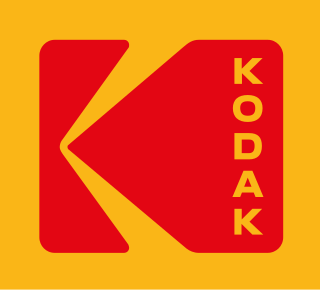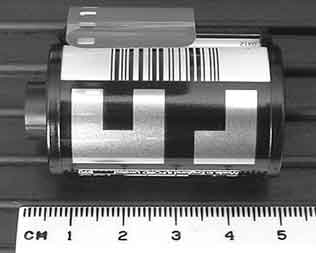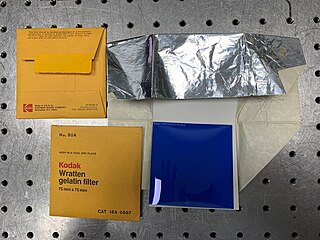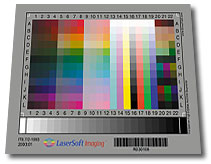Related Research Articles

The Eastman Kodak Company is an American public company that produces various products related to its historic basis in analogue photography. The company is headquartered in Rochester, New York, and is incorporated in New Jersey. Kodak provides packaging, functional printing, graphic communications, and professional services for businesses around the world. Its main business segments are Print Systems, Enterprise Inkjet Systems, Micro 3D Printing and Packaging, Software and Solutions, and Consumer and Film. It is best known for photographic film products.
The following list comprises significant milestones in the development of photography technology.
Gamma correction or gamma is a nonlinear operation used to encode and decode luminance or tristimulus values in video or still image systems. Gamma correction is, in the simplest cases, defined by the following power-law expression:

DX encoding is an ANSI and I3A standard, originally introduced by Kodak in March 1983, for marking 135 and APS photographic film and film cartridges. It consists of several parts, a latent image DX film edge barcode on the film below the sprocket holes, a code on the cartridge used by automatic cameras, and a barcode on the cartridge read by photo-finishing machines.

Kodachrome is the brand name for a color reversal film introduced by Eastman Kodak in 1935. It was one of the first successful color materials and was used for both cinematography and still photography. For many years Kodachrome was widely used for professional color photography, especially for images intended for publication in print media.

FUJIFILM Holdings Corporation, trading as Fujifilm, or simply Fuji, is a Japanese multinational conglomerate headquartered in Tokyo, Japan, operating in the realms of photography, optics, office and medical electronics, biotechnology, and chemicals.

In photography, reversal film or slide film is a type of photographic film that produces a positive image on a transparent base. Instead of negatives and prints, reversal film is processed to produce transparencies or diapositives. Reversal film is produced in various sizes, from 35 mm to roll film to 8×10 inch sheet film.
Creo, now part of Eastman Kodak Company, was a Burnaby, British Columbia, Canada-based company, involved in imaging and software technology for computer to plate and digital printing. The name derives from the Latin creo, "I create."
The Cineon System was one of the first computer based digital film systems, created by Kodak in the early 1990s. It was an integrated suite of components consisting a Motion picture film scanner, a film recorder and workstation hardware with software for compositing, visual effects, image restoration and color management.

Photo CD is a system designed by Kodak for digitizing and saving photos onto a CD. Launched in 1991, the discs were designed to hold nearly 100 high quality images, scanned prints and slides using special proprietary encoding. Photo CDs are defined in the Beige Book and conform to the CD-ROM XA and CD-i Bridge specifications as well. They were intended to play on CD-i players, Photo CD players, and any computer with a suitable software.
Bryce Edward Bayer was an American scientist who invented the Bayer filter, which is used in most modern digital cameras. He has been called "the maestro without whom photography as we know wouldn't have been the same." Without his filter, Larry Scarff, a former chairman of the Camera Phone Image Quality Standards Group, told The New York Times after Bayer's death, "we'd still be getting only black-and-white pictures from our digital cameras."
Digital ICE or Digital Image Correction and Enhancement is a set of technologies related to producing an altered image in a variety of frequency spectra. The objective of these technologies is to render an image more usable by Fourier or other filtering techniques. These technologies were most actively advanced in the 1960s and early 1970s in the fields of strategic reconnaissance and medical electronics.

Wratten numbers are a labeling system for optical filters, usually for photographic use comprising a number sometimes followed by a letter. The number denotes the color of the filter, but is arbitrary and does not encode any information ; letters almost always increase with increasing strength.

Color motion picture film refers both to unexposed color photographic film in a format suitable for use in a motion picture camera, and to finished motion picture film, ready for use in a projector, which bears images in color.

Carestream Health, formerly Eastman Kodak Company's Health Group, is an independent subsidiary of Onex Corporation which is one of Canada's largest corporations.

A color chart or color reference card is a flat, physical object that has many different color samples present. They can be available as a single-page chart, or in the form of swatchbooks or color-matching fans.

Loyd Ancile Jones was an American scientist who worked for Eastman Kodak Company, where he was head of its physics department for many years. During World War I, he was also a major contributor to the development of naval camouflage.
L3Harris Geospatial develops products for the visualization, analysis, and management of geospatial imagery and scientific data. The company develops products such as IDL, ENVI, and Jagwire which are used in a variety of industries including defense and intelligence, environmental, engineering, aerospace, medical imaging, and federal and civil governments worldwide.
Kodak Proofing Software is an application from Eastman Kodak for managing and controlling the process of Prepress proofing. It supports the Veris printer, Kodak Approval and various inkjet printers from Epson and Hewlett Packard.
Vince Ferraro is an American business executive best known for his global marketing vice president positions with Hewlett-Packard and Eastman Kodak.
References
- ↑ Digital Color Management Encoding Solutions, First Edition, Addison Wesley, 1997.